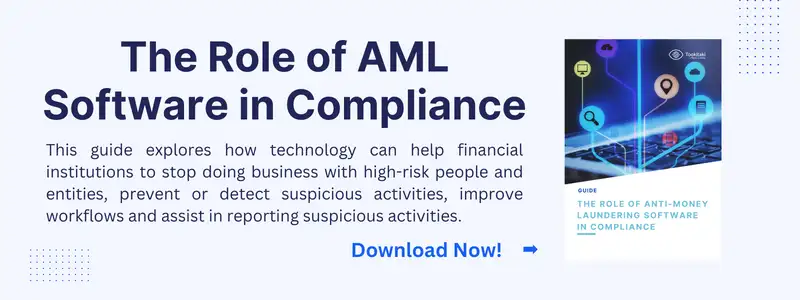Creating an Effective AML Compliance Program: A Comprehensive Guide
In today's fast-changing financial world, having a strong Anti-Money Laundering (AML) compliance program is essential for banks and fintech companies. Such programs help organizations follow laws and prevent crimes like money laundering, terrorist funding, and fraud. Building a solid AML compliance program means knowing its key parts, using best practices, and using advanced technology to stay compliant and fight against illegal activities.
This guide will explain the main elements of an AML compliance program, show practical steps for setting one up, and offer tips to tackle common challenges. This way, your organization can stay protected and ahead in preventing financial crimes. Let's explore the details of AML compliance programs, understand their importance, and learn how to create an effective system that keeps your institution and customers safe.
Understanding AML Compliance Programs
What is an AML Compliance Program?
An AML compliance program is a set of procedures and policies designed to help financial institutions detect and prevent money laundering, terrorist financing, and other illegal activities. These programs ensure that companies comply with laws and regulations, such as the Bank Secrecy Act (BSA) in the United States. The goal is to identify suspicious transactions and report them to the appropriate authorities.
Importance of AML Compliance
Having an effective AML compliance program is crucial for several reasons:
- Legal Requirements: Financial institutions must comply with national and international laws to avoid severe penalties and fines.
- Preventing Financial Crimes: An AML program helps detect and prevent crimes like money laundering and terrorist financing.
- Protecting Reputation: Companies with strong AML programs are trusted more by customers and partners, protecting their reputation.
- Financial Stability: By preventing illicit activities, AML programs help maintain the financial stability of institutions and the broader economy.
An AML compliance program typically includes several key elements, such as developing internal policies, designating an AML compliance officer, ongoing employee training, independent testing, and customer due diligence.
Key Elements of an AML Compliance Program
Internal Policies and Procedures
Creating comprehensive internal policies and procedures is the foundation of an effective AML compliance program. These policies should outline the steps your organization will take to detect and prevent money laundering activities. Key components include:
- Transaction Monitoring: Regularly monitoring transactions to identify suspicious activities.
- Record Keeping: Maintaining detailed records of transactions for a specified period.
- Reporting: Establishing protocols for reporting suspicious activities to regulatory authorities.
Designation of an AML Compliance Officer
An AML compliance officer is responsible for ensuring that the organization adheres to AML regulations. This person should have the authority, resources, and training to effectively manage the compliance program. Their duties include:
- Overseeing the implementation of AML policies and procedures.
- Ensuring that the organization complies with all relevant laws and regulations.
- Acting as a liaison with regulatory bodies.
Employee Training and Education
Regular training and education are essential to keep employees informed about AML regulations and best practices. This training should cover:
- How to identify and report suspicious activities.
- Understanding the organization's AML policies and procedures.
- The legal requirements related to AML compliance.
Independent Testing and Review
To ensure the effectiveness of the AML compliance program, independent testing and review should be conducted periodically. This can be done by internal auditors or external parties. The review should assess:
- The adequacy and effectiveness of the AML policies and procedures.
- The compliance officer's performance.
- The overall effectiveness of the employee training program.
Customer Due Diligence (CDD)
Customer Due Diligence involves verifying the identity of customers and assessing their risk level. This process includes:
- Collecting and verifying customer information.
- Monitoring customer transactions for suspicious activities.
- Updating customer information regularly.
Utilizing an AML Compliance Program Template
Creating a robust AML compliance program from scratch can be daunting. To streamline the process, organizations can use an AML compliance program template. This template serves as a comprehensive guide, ensuring that all critical components of an AML program are covered effectively. Here’s how you can leverage a template to build an effective AML compliance program:
Benefits of Using an AML Compliance Program Template
-
Structured Framework: A template provides a structured framework that outlines the necessary steps and components required for a complete AML compliance program. This includes internal policies, procedures, customer due diligence, and employee training protocols.
-
Time Efficiency: Using a pre-designed template saves time by eliminating the need to develop policies and procedures from scratch. This allows your team to focus on implementing and customizing the program to fit your organization’s specific needs.
-
Compliance Assurance: Templates are often designed based on industry best practices and regulatory requirements. By following a template, you ensure that your AML compliance program adheres to the necessary legal standards and reduces the risk of non-compliance.
-
Customization Flexibility: While a template provides a solid foundation, it can be customized to address the unique risks and requirements of your organization. This flexibility ensures that your AML compliance program is both comprehensive and tailored to your specific operational environment.
Steps to Building Your AML Compliance Program
Below is a table summarizing the steps to building your AML compliance program.
| Step | Description |
|---|---|
| Implementing a Customer Identification Program (CIP) | The first step in building an AML compliance program is to implement a Customer Identification Program (CIP). A CIP ensures that your organization knows and can verify the true identity of its customers. Key steps include: |
| Collecting Information | Gather essential information from customers, such as their name, date of birth, address, and identification number. |
| Verification | Verify the collected information using reliable, independent sources like government-issued IDs or credit reports. |
| Record Keeping | Maintain records of the identification information and verification methods used. |
| Conducting Risk-Based Due Diligence | Risk-based due diligence is crucial for effectively managing AML compliance. This process involves assessing the risk level of each customer based on factors like their geographical location, transaction types, and account activity. Steps include: |
| Risk Assessment | Categorize customers into risk levels (low, medium, high) based on predetermined criteria. |
| Enhanced Due Diligence | Perform additional checks for high-risk customers, such as obtaining more detailed information and conducting in-depth investigations. |
| Ongoing Monitoring | Continuously monitor customer transactions and update their risk profiles as needed. |
| Automating AML Processes | Leveraging technology to automate AML processes can greatly enhance efficiency and accuracy. Automated systems can help with: |
| Identity Verification | Use automated solutions to quickly verify customer identities during onboarding. |
| Transaction Monitoring | Implement software to continuously monitor transactions for suspicious activities and generate alerts. |
| Record Management | Utilize digital systems to maintain and organize records, making it easier to retrieve information during audits or investigations. |
By following these steps, your organization can build a robust AML compliance program that not only meets regulatory requirements but also helps prevent financial crimes.
Best Practices for Maintaining AML Compliance
Regularly Updating Policies and Procedures
To ensure the continued effectiveness of your AML compliance program, it is crucial to regularly update your policies and procedures. This involves:
- Staying Informed: Keep abreast of changes in AML regulations and industry best practices.
- Periodic Reviews: Conduct regular reviews of your AML policies to identify areas that need updating or improvement.
- Feedback Integration: Incorporate feedback from audits, regulatory reviews, and employee suggestions into your policy updates.
Continuous Monitoring and Reporting
Continuous monitoring of customer transactions and timely reporting of suspicious activities are vital for maintaining AML compliance. Key practices include:
- Real-Time Monitoring: Use advanced software solutions to monitor transactions in real-time and flag suspicious activities.
- Regular Audits: Conduct internal audits to ensure compliance with AML policies and identify any gaps or weaknesses.
- Suspicious Activity Reports (SARs): Promptly file SARs with the appropriate regulatory bodies whenever suspicious activities are detected.
Integrating Advanced Technology Solutions
Utilizing advanced technology can significantly enhance the efficiency and effectiveness of your AML compliance program. Consider the following:
- Artificial Intelligence and Machine Learning: Implement AI and ML solutions to analyze transaction patterns and detect anomalies more accurately.
- Cloud-Based Solutions: Leverage cloud-based platforms for scalable and cost-effective compliance management.
Common Challenges and How to Overcome Them
Navigating Complex Regulations
One of the most significant challenges in AML compliance is keeping up with complex and constantly changing regulations. Financial institutions must stay informed about both local and international AML laws. Strategies to overcome this challenge include:
- Dedicated Compliance Team: Establish a team responsible for monitoring regulatory changes and ensuring compliance.
- Regular Training: Provide ongoing training for employees to keep them updated on the latest AML regulations and best practices.
- Consultation with Experts: Engage with legal and compliance experts to interpret and implement complex regulations effectively.
Managing False Positives and Negatives
False positives (legitimate transactions flagged as suspicious) and false negatives (suspicious transactions not flagged) can hinder the effectiveness of an AML program. To manage these issues:
- Refine Algorithms: Continuously improve the algorithms and parameters used in transaction monitoring systems to reduce false positives and negatives.
- Use Advanced Technologies: Implement AI and machine learning solutions to enhance the accuracy of transaction monitoring.
- Regular Reviews: Conduct regular reviews of flagged transactions to identify patterns and adjust monitoring criteria accordingly.
Balancing Customer Experience with Compliance Requirements
Maintaining a balance between strict AML compliance and providing a smooth customer experience can be challenging. Strategies to address this include:
- Risk-Based Approach: Focus more rigorous checks on high-risk customers while streamlining processes for low-risk customers to reduce friction.
- Automation: Use automated identity verification and transaction monitoring systems to speed up compliance processes without compromising on security.
- Clear Communication: Inform customers about the importance of AML compliance and how it benefits them, improving their understanding and cooperation.
By addressing these common challenges, financial institutions can strengthen their AML compliance programs and ensure they effectively prevent financial crimes while maintaining good customer relationships.
Final Thoughts
In the fight against financial crimes, establishing a robust Anti-Money Laundering (AML) compliance program is essential for any financial institution or fintech company. By understanding the key elements, implementing best practices, and overcoming common challenges, organizations can ensure they stay compliant with regulations and protect themselves from illicit activities.
Creating a comprehensive AML compliance program involves setting up internal policies and procedures, designating a compliance officer, conducting regular employee training, performing independent reviews, and practicing thorough customer due diligence. Leveraging advanced technologies and adopting a risk-based approach can further enhance the effectiveness of your AML efforts.
Staying vigilant and proactive in updating your AML strategies and tools will not only help in complying with legal requirements but also in safeguarding your institution's reputation and financial stability. By doing so, you contribute to a safer and more secure financial system.
Discover how Tookitaki's innovative AML solutions can help your organization stay ahead in the fight against financial crimes. Explore our FinCense platform to see how our cutting-edge technology can streamline your compliance processes and reduce risks. Contact us today to learn more about how we can support your AML compliance needs.
Anti-Financial Crime Compliance with Tookitaki?





